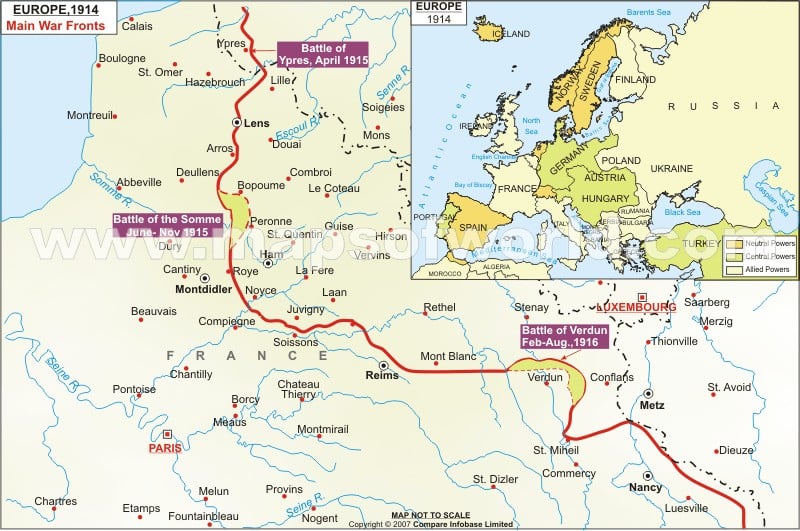Also known as the First World War and before the outbreak of World War II, as the Great War, World War I involved most of the countries of Europe and was fought primarily in Europe.
The main opposing forces were the Central Powers, which were Germany, Austria-Hungary and Turkey against the Allies, where were composed of Great Britain, France, Italy, Russia, Japan, and subsequently, the United States.
The death and destruction in the wake of this disastrous event was unprecedented in world history and assumed catastrophic proportions as the war swept across Europe and other parts of the world including parts of Asia. The World War I Europe Map shows a geopolitical map of Europe on the eve of the war and the location of the various European theaters of war, where some of the fiercest and most bloody battles were fought.
First Battle of the Marne : Fought from September 6 to 12,1914, the First Battle of the Marne was a counter offensive undertaken by the French army and the British Expeditionary Force to halt the German advance towards the French capital Paris. Earlier in the war, the Germans had overrun Belgium and most of northeastern France to reach just 30 miles outside of Paris, thereby forcing the Allies to retreat toward the Marne River. The counterattack resulted in a decisive victory for the French and the English who stopped the German advance towards Paris that would have resulted in a total German victory on the Western Front of the war.
Battle of Tannenberg : While the German advance on the Western Front was stopped at Marne, on the Eastern Front they were engaged by a 3,50,000 soldier strong Russian army at Tannenberg (present-day northeastern Poland). But at Tannenberg, the Germans handed out a crushing defeat to the Russians, with heavy Russian casualties. Imperial Russia lost almost an entire army, and the victory was one of the greatest for Germany in World War I. On the other hand, the Germans, in order to halt this Russian attack on East Prussia, had to divert troops from their advance towards Paris, which was crucial to their French campaign, and which ultimately was repulsed by the Allies at Marne.
First Battle of Ypres : Also called the Battle of Flanders, the First Battle of Ypres was fought during October and November of 1914, and was the last major battle of the first stage of World War I on the Western Front. After rebuffing the German advance toward Paris with the Allied victory at Marne, both sides tried to swing around the others defenses to outflank one another. The result was what has been called the Race to the Sea, which ended with the First battle of Ypres in Belgium and the subsequent Battle of the Yser. Although the German attack was once again repulsed at Ypres, both armies became too exhausted to carry out any major offensive against each other. As a result both sides settled down to prolonged trench warfare. The line of trenches dug by both sides extended from the Swiss frontier to the English Channel on the Atlantic Coast of Europe. The stalemate that ensued with the trench warfare lasted for the next three years and largely characterized the military engagements on the Western Front during that period.
Battle of Verdun : From 1914 until early 1916, the Allies’ efforts were geared toward breaking the deadlock that had set in as a result of the prolonged trench warfare. All along during this period, the Allies, especially the British, tried to consolidate their strength in terms of both men and material in order to launch a major offensive to end the trench stalemate. The Germans were also frustrated by the long stalemate and were looking for an opportunity to strike and break through the French defenses. Ultimately the Germans chose to attack the town of Verdun, which was fortified by a ring of underground trenches. The massive German offensive on Verdun that lasted from February to July 1916 proved to be one of the longest and most devastating battles of the war and resulted in heavy casualties on both sides. The end result was maintenance of status quo, with the Germans unable to break through the French defenses and the French recapturing most of their strongholds lost during the German offensive on Verdun. The offensive ended when the German attention was diverted to the Allied attack on the Somme River.
Battle of the Somme : Fought from July 1 to November 18, 1916, the Battle of the Somme was an Allied offensive aimed at diverting German attention from the assault on Verdun and relieve pressure on the French forces there. But the offensive proved largely unsuccessful although it managed to divert the Germans from Verdun and therefore secure the French defenses on the Western Front. In the process, Britain and France lost nearly three quarters of a million men, and on the first day of the campaign itself, Britain lost nearly 20,000 soldiers – the largest number of deaths on a single day in British military history. The Battle of the Somme would go down in history as one of the bloodiest battles where thousands of human lives were unnecessarily slaughtered in a futile exercise.

 Kaiser Wilhelm II
Kaiser Wilhelm II